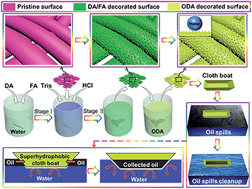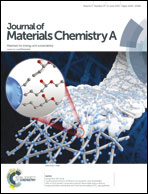A novel mussel-inspired strategy toward superhydrophobic surfaces for self-driven crude oil spill cleanup†
Abstract
The current available superhydrophobic modification techniques that utilize mussel-inspired polydopamine (pDA) to construct hierarchical structures require the addition of nanoparticles or the usage of a high concentration of dopamine. These requirements are expensive and therefore lower the application efficiency. Herein, for the first time, a superhydrophobic fabric was prepared by a novel and simple mussel-inspired strategy with a much lower concentration of dopamine without any additional nanoparticles. Folic acid (FA) was first applied to a surface to induce the formation of rough pDA coatings with hierarchical structures. These hierarchical structures can be readily controlled by adjusting FA concentration or coating duration. After octadecylamine (ODA) chemical manipulation, the obtained fabric exhibited water contact and rolling off angles of about 162° and 7°, respectively, indicating that it was endowed with superhydrophobicity. Importantly, the superhydrophobic fabric can withstand continuous and drastic 3.5 wt% NaCl solution rinses and repeated tearing with an adhesive tape more than 30 times, suggesting that it has excellent durability. This novel mussel-inspired strategy can facilely and cost-effectively realize superhydrophobic manipulation and tailoring of materials. Moreover, an energy-saving and highly-efficient mini boat fabricated from our novel superhydrophobic fabric was utilized for self-driven oil spill cleanup. The boat can automatically recycle crude oil spills while floating freely on water with a cleanup rate of crude oil spill up to 97.1%, demonstrating great potential in environmental remediation. The novel strategy designed in this study will inspire the fast development of mussel-inspired superhydrophobic materials for applications in various fields.


 Please wait while we load your content...
Please wait while we load your content...